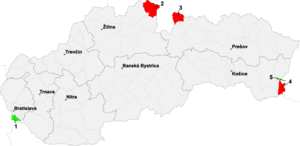Bratislava bridgehead
48°4′42″N 17°7′32″E / 48.07833°N 17.12556°E Bratislava bridgehead is an area with 93,7 km² at the Western part of today Slovakia at the Little Hungarian Plain, on the left bank of river Danube. Administratively it belongs to Bratislava V in Bratislava. It consists of the modern Čunovo, Jarovce, Rusovce and Petržalka. It has 111.135 inhabitants.
History
As a result of the Treaty of Trianon the peace treaty of Hungary signed at the end of First World War there was made a bridgehead for Czechoslovakia at the right bank of Danube at Bratislava. It had mainly defensive features. At this time Petržalka was transferred to the newly founded country.
In October 1938 as part of the Munich Agreement, Petržalka and Devín were transferred to the Nazi Germany for strategical purposes.
At the end of the war, ceasefire agreements gave back all of the territories annexed in Slovakia except Carpathian Ruthenia It became part of the Ukraine in the Soviet Union as per the Moscow Agreement. Camp for Hungarians and Germans impeached for war crimes was located at Petržalka.

It was an idea of the delegation of Czechoslovakia at the Paris Peace Conference that they would need an extended defensive territory at the Bratislava bridgehead. They required to get Čunovo, Jarovce, Rusovce, Rajka and Bezenye First three of them were given to the Slavic state, with a territory of 62 km².
There was built a microdistrict during the 1970s at Petržalka with a population of 100,000 inhabitants. Today all of the four villages are part of Bratislava V.
Between 1977 and 1992 there was built here the Gabčíkovo–Nagymaros Dams. The bridgehead makes possible the abstraction of the water to Slovakia.